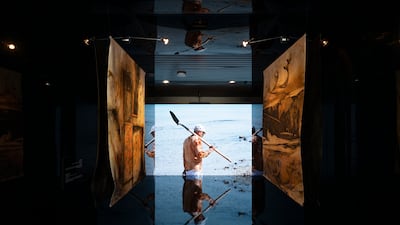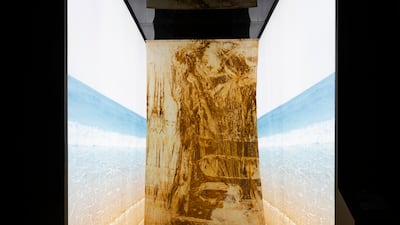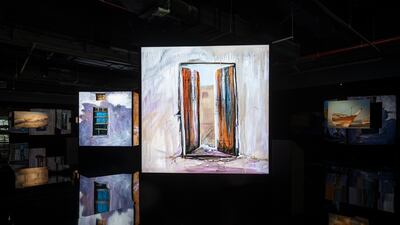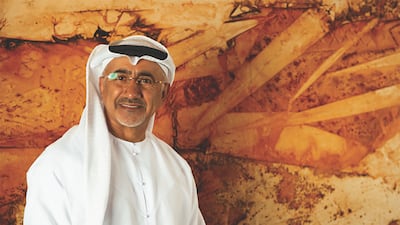Sand, saltwater, time and rust are among Mohamed Al Astad’s favourite tools as an artist.
The Emirati artist takes regular excursions to the beaches of the country, particularly of his home town of Khor Fakkan, to bury large canvases along with pieces of iron along the shoreline.
He then leaves them there for a week, returning to find that the oxidisation process has left the orange-brown prints on the canvas. He then washes the canvas in the sea to remove any excess rust, waste and sand, before taking it home and washing it again, this time with fresh water, to rid the canvas of any salt remnants that may cause the fibres to deteriorate.
It is a technique Al Astad has spent the last 24 years developing, an artistic collaboration, he says, with the sea that has captivated him since he was a boy, collecting seashells and chasing seagulls on the shore.
“It is a conversation with the beach,” he says. “I’m talking with the sand, to that heat, to that pressure. It’s as if nature is asking me to make art with it. It doesn’t know how to draw a horse, so I make the silhouette of a horse in iron, bury it in sand, and it gives me its own variation of it. It draws a horse in its own way.”
The fine-tuning of Al Astad’s technique is axiomatic in the works on display in his solo exhibition Another Perspective, which is showing at the Cultural Foundation until September 20.
In fact, the welcoming work that viewers will first see when they walk into the space is likely Al Astad’s dearest of the bunch.
Instead of canvas, the work bears oxidised patterns on silk, six metres long and a little over a metre in width. The rust bleeds on the material in a way that is reminiscent of watercolours. Draped at an angle towards the floor, the work is set between two screens showing videos of waves rolling towards the beach. Fans are positioned behind the work, which produce an undulating wave-like motion along the length of the silk.
Al Astad calls the technique danat al shawati or the art of beach pearls. The idea, he says, first came to him when he returned from his studies at the American University in Washington DC in 1998. He says he was looking for something to set him and his work apart.
“I felt I had to find myself in the universe,” he says. “I didn’t want to emulate.”
He was at first inspired by a tarp that covered a boat that had been ashore for years. It was discoloured by grime and the droppings of seagulls.
“I cut it from the middle and made four paintings out of it,” he says. “I didn’t touch it, merely signed it and framed it. I booked a small area at the Abu Dhabi National Exhibition Centre and displayed the works. I was curious how people would see them.”
The works brought an overwhelmingly positive reaction, Al Astad says. He adds that he was stunned, having approached the experiment with a degree of cynicism. He then thought of how he could contribute to the haphazard designs that nature and time left behind on the beach.
A rusted nail, he says, gave him the answer.
“Just seeing the orange-brown build up and the varying shades inspired me,” he says.
He first tried burying saffron and pomegranates with the iron as well, hoping that their intense hues would be transferred onto the canvas. But when he returned to exhume the work a week later, there were no traces of either. Only the iron, and the traces of its oxidisation remained.
“I could make out patterns, faces and figures emerging from the work,” he says.
He began fiercely experimenting with the technique, burying works in holes of different depths, leaving them across varying durations and adding different hues to the canvas. He has lost many works to the tide, he says. Some canvases were torn and washed away by the waves and then there are those that could very well still be forgotten in the sands along the country’s coasts. He has also created clothes using the method, including T-shirts and even ghutras.
The process, he says, of digging a hole and burying the canvas or silk, washing the material in the sea and seeing the patterns left to him over time is like therapy.
“It’s meditative,” he says. “You never know what’s going to happen. Open waters leave a different result than closed ones, such as khors since they’re shallow. In places where there are no waves, you don’t need to dig deep, even 10 centimetres would do. In beaches along open waters, I dig more than a metre down. If not, the waves will take the artwork away.”
Al Astad regularly holds workshops to teach his technique to others. He says he is always pleasantly surprised by how people apply his technique.
“I’ve given several workshops on danat al shawati,” he says. “Among the most memorable was the one I held at Zayed University with 20 female art students. We even held the exhibition at the beach.”
Al Astad has taken part in more than 300 group exhibitions in the UAE, Italy, Belgium, Britain and Germany. He has also held 40 solo exhibitions around the world.
The exhibition at the Cultural Foundation, however, marks a new chapter in his career, he says. While many may know the artist for his depictions of Emirati cultural motifs and traditional architecture — the exhibition has plenty of these as well — he says he hopes Another Perspective offers a different, more holistic vantage point of his work.
Another Perspective opened at the Cultural Foundation in March and will be concluding on September 20.
Sunday:
GP3 race: 12:10pm
Formula 2 race: 1:35pm
Formula 1 race: 5:10pm
Performance: Guns N' Roses
Who was Alfred Nobel?
The Nobel Prize was created by wealthy Swedish chemist and entrepreneur Alfred Nobel.
- In his will he dictated that the bulk of his estate should be used to fund "prizes to those who, during the preceding year, have conferred the greatest benefit to humankind".
- Nobel is best known as the inventor of dynamite, but also wrote poetry and drama and could speak Russian, French, English and German by the age of 17. The five original prize categories reflect the interests closest to his heart.
- Nobel died in 1896 but it took until 1901, following a legal battle over his will, before the first prizes were awarded.
PROFILE OF HALAN
Started: November 2017
Founders: Mounir Nakhla, Ahmed Mohsen and Mohamed Aboulnaga
Based: Cairo, Egypt
Sector: transport and logistics
Size: 150 employees
Investment: approximately $8 million
Investors include: Singapore’s Battery Road Digital Holdings, Egypt’s Algebra Ventures, Uber co-founder and former CTO Oscar Salazar
Labour dispute
The insured employee may still file an ILOE claim even if a labour dispute is ongoing post termination, but the insurer may suspend or reject payment, until the courts resolve the dispute, especially if the reason for termination is contested. The outcome of the labour court proceedings can directly affect eligibility.
- Abdullah Ishnaneh, Partner, BSA Law
Skoda Superb Specs
Engine: 2-litre TSI petrol
Power: 190hp
Torque: 320Nm
Price: From Dh147,000
Available: Now
The%20Sandman
%3Cp%3ECreators%3A%20Neil%20Gaiman%2C%20David%20Goyer%2C%20Allan%20Heinberg%3C%2Fp%3E%0A%3Cp%3EStars%3A%20Tom%20Sturridge%2C%20Boyd%20Holbrook%2C%20Jenna%20Coleman%20and%20Gwendoline%20Christie%3C%2Fp%3E%0A%3Cp%3ERating%3A%204%2F5%3C%2Fp%3E%0A
Groom and Two Brides
Director: Elie Semaan
Starring: Abdullah Boushehri, Laila Abdallah, Lulwa Almulla
Rating: 3/5
Key facilities
- Olympic-size swimming pool with a split bulkhead for multi-use configurations, including water polo and 50m/25m training lanes
- Premier League-standard football pitch
- 400m Olympic running track
- NBA-spec basketball court with auditorium
- 600-seat auditorium
- Spaces for historical and cultural exploration
- An elevated football field that doubles as a helipad
- Specialist robotics and science laboratories
- AR and VR-enabled learning centres
- Disruption Lab and Research Centre for developing entrepreneurial skills
GOLF’S RAHMBO
- 5 wins in 22 months as pro
- Three wins in past 10 starts
- 45 pro starts worldwide: 5 wins, 17 top 5s
- Ranked 551th in world on debut, now No 4 (was No 2 earlier this year)
- 5th player in last 30 years to win 3 European Tour and 2 PGA Tour titles before age 24 (Woods, Garcia, McIlroy, Spieth)
Jetour T1 specs
Engine: 2-litre turbocharged
Power: 254hp
Torque: 390Nm
Price: From Dh126,000
Available: Now
How to register as a donor
1) Organ donors can register on the Hayat app, run by the Ministry of Health and Prevention
2) There are about 11,000 patients in the country in need of organ transplants
3) People must be over 21. Emiratis and residents can register.
4) The campaign uses the hashtag #donate_hope
The years Ramadan fell in May
List of alleged parties
- May 15 2020: Boris Johnson is said to have attended a Downing Street pizza party
- 27 Nov 2020: PM gives speech at leaving do for his staff
- Dec 10 2020: Staff party held by then-education secretary Gavin Williamson
- Dec 13 2020: Mr Johnson and his then-fiancee Carrie Symonds throw a flat party
- Dec 14 2020: Shaun Bailey holds staff party at Conservative Party headquarters
- Dec 15 2020: PM takes part in a staff quiz
- Dec 18 2020: Downing Street Christmas party
The biog
Name: Dhabia Khalifa AlQubaisi
Age: 23
How she spends spare time: Playing with cats at the clinic and feeding them
Inspiration: My father. He’s a hard working man who has been through a lot to provide us with everything we need
Favourite book: Attitude, emotions and the psychology of cats by Dr Nicholes Dodman
Favourit film: 101 Dalmatians - it remind me of my childhood and began my love of dogs
Word of advice: By being patient, good things will come and by staying positive you’ll have the will to continue to love what you're doing
GAC GS8 Specs
Engine: 2.0-litre 4cyl turbo
Power: 248hp at 5,200rpm
Torque: 400Nm at 1,750-4,000rpm
Transmission: 8-speed auto
Fuel consumption: 9.1L/100km
On sale: Now
Price: From Dh149,900
Teaching your child to save
Pre-school (three - five years)
You can’t yet talk about investing or borrowing, but introduce a “classic” money bank and start putting gifts and allowances away. When the child wants a specific toy, have them save for it and help them track their progress.
Early childhood (six - eight years)
Replace the money bank with three jars labelled ‘saving’, ‘spending’ and ‘sharing’. Have the child divide their allowance into the three jars each week and explain their choices in splitting their pocket money. A guide could be 25 per cent saving, 50 per cent spending, 25 per cent for charity and gift-giving.
Middle childhood (nine - 11 years)
Open a bank savings account and help your child establish a budget and set a savings goal. Introduce the notion of ‘paying yourself first’ by putting away savings as soon as your allowance is paid.
Young teens (12 - 14 years)
Change your child’s allowance from weekly to monthly and help them pinpoint long-range goals such as a trip, so they can start longer-term saving and find new ways to increase their saving.
Teenage (15 - 18 years)
Discuss mutual expectations about university costs and identify what they can help fund and set goals. Don’t pay for everything, so they can experience the pride of contributing.
Young adulthood (19 - 22 years)
Discuss post-graduation plans and future life goals, quantify expenses such as first apartment, work wardrobe, holidays and help them continue to save towards these goals.
* JP Morgan Private Bank
Where to donate in the UAE
The Emirates Charity Portal
You can donate to several registered charities through a “donation catalogue”. The use of the donation is quite specific, such as buying a fan for a poor family in Niger for Dh130.
The General Authority of Islamic Affairs & Endowments
The site has an e-donation service accepting debit card, credit card or e-Dirham, an electronic payment tool developed by the Ministry of Finance and First Abu Dhabi Bank.
Al Noor Special Needs Centre
You can donate online or order Smiles n’ Stuff products handcrafted by Al Noor students. The centre publishes a wish list of extras needed, starting at Dh500.
Beit Al Khair Society
Beit Al Khair Society has the motto “From – and to – the UAE,” with donations going towards the neediest in the country. Its website has a list of physical donation sites, but people can also contribute money by SMS, bank transfer and through the hotline 800-22554.
Dar Al Ber Society
Dar Al Ber Society, which has charity projects in 39 countries, accept cash payments, money transfers or SMS donations. Its donation hotline is 800-79.
Dubai Cares
Dubai Cares provides several options for individuals and companies to donate, including online, through banks, at retail outlets, via phone and by purchasing Dubai Cares branded merchandise. It is currently running a campaign called Bookings 2030, which allows people to help change the future of six underprivileged children and young people.
Emirates Airline Foundation
Those who travel on Emirates have undoubtedly seen the little donation envelopes in the seat pockets. But the foundation also accepts donations online and in the form of Skywards Miles. Donated miles are used to sponsor travel for doctors, surgeons, engineers and other professionals volunteering on humanitarian missions around the world.
Emirates Red Crescent
On the Emirates Red Crescent website you can choose between 35 different purposes for your donation, such as providing food for fasters, supporting debtors and contributing to a refugee women fund. It also has a list of bank accounts for each donation type.
Gulf for Good
Gulf for Good raises funds for partner charity projects through challenges, like climbing Kilimanjaro and cycling through Thailand. This year’s projects are in partnership with Street Child Nepal, Larchfield Kids, the Foundation for African Empowerment and SOS Children's Villages. Since 2001, the organisation has raised more than $3.5 million (Dh12.8m) in support of over 50 children’s charities.
Noor Dubai Foundation
Sheikh Mohammed bin Rashid Al Maktoum launched the Noor Dubai Foundation a decade ago with the aim of eliminating all forms of preventable blindness globally. You can donate Dh50 to support mobile eye camps by texting the word “Noor” to 4565 (Etisalat) or 4849 (du).
RESULT
Deportivo La Coruna 2 Barcelona 4
Deportivo: Perez (39'), Colak (63')
Barcelona: Coutinho (6'), Messi (37', 81', 84')
Another way to earn air miles
In addition to the Emirates and Etihad programmes, there is the Air Miles Middle East card, which offers members the ability to choose any airline, has no black-out dates and no restrictions on seat availability. Air Miles is linked up to HSBC credit cards and can also be earned through retail partners such as Spinneys, Sharaf DG and The Toy Store.
An Emirates Dubai-London round-trip ticket costs 180,000 miles on the Air Miles website. But customers earn these ‘miles’ at a much faster rate than airline miles. Adidas offers two air miles per Dh1 spent. Air Miles has partnerships with websites as well, so booking.com and agoda.com offer three miles per Dh1 spent.
“If you use your HSBC credit card when shopping at our partners, you are able to earn Air Miles twice which will mean you can get that flight reward faster and for less spend,” says Paul Lacey, the managing director for Europe, Middle East and India for Aimia, which owns and operates Air Miles Middle East.
FROM%20THE%20ASHES
%3Cp%3EDirector%3A%20Khalid%20Fahad%3C%2Fp%3E%0A%3Cp%3EStarring%3A%20Shaima%20Al%20Tayeb%2C%20Wafa%20Muhamad%2C%20Hamss%20Bandar%3C%2Fp%3E%0A%3Cp%3ERating%3A%203%2F5%3C%2Fp%3E%0A









